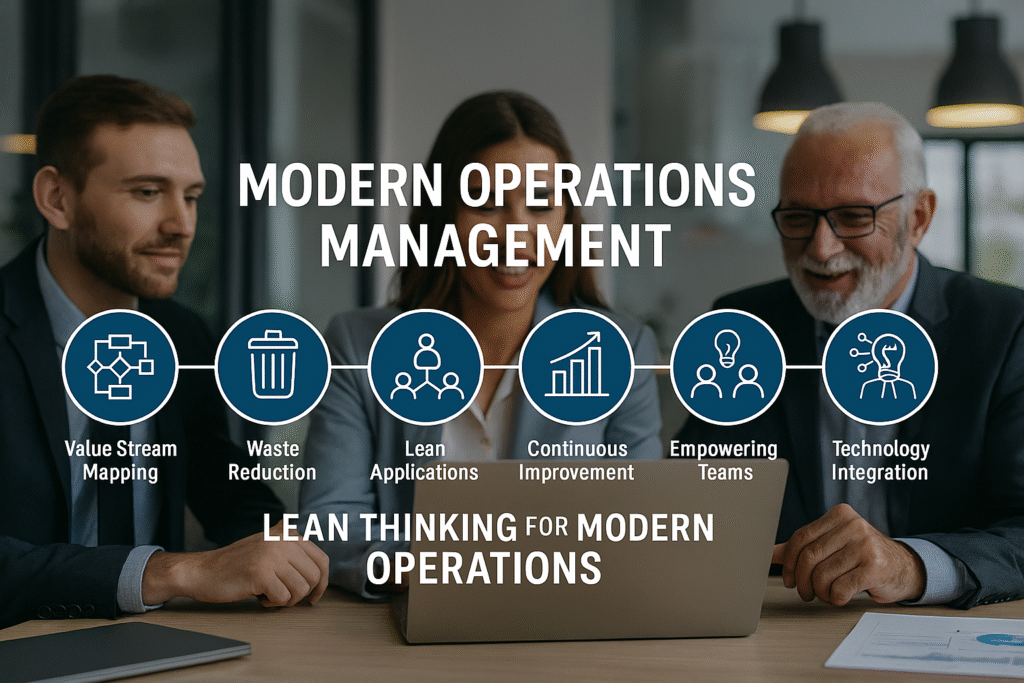Introduction
Lean Thinking for Modern Operations is no longer a buzzword—it’s a practical philosophy that helps businesses stay competitive in fast-changing markets. Whether you’re managing manufacturing, services, or digital workflows, understanding Lean principles is crucial. In this article, you’ll discover what Lean Thinking means today, why it matters, and how to apply it with real-world examples and practical steps. Get ready to unlock new levels of efficiency and customer value!
What is Lean Thinking for Modern Operations?
Lean Thinking for Modern Operations refers to the systematic approach of eliminating waste, optimizing processes, and delivering maximum value to customers. Initially rooted in manufacturing, Lean now spans industries like healthcare, IT, logistics, and service sectors.
It’s about questioning every process step: Does it add value for the customer? If not, how can we remove it, simplify it, or automate it?
Read more about the broader applications of Lean in operations on aiiem.org.
Why Lean Thinking Matters in Modern Business
Businesses today face volatile markets, demanding customers, and digital disruption. Lean Thinking for Modern Operations enables organizations to:
- Lower operational costs
- Improve speed and flexibility
- Enhance customer satisfaction
- Build a culture of continuous improvement
According to McKinsey & Company, companies that implement Lean see productivity increases of up to 40% and significant cost reductions.
Key Principles of Lean Thinking
At the heart of Lean Thinking for Modern Operations lie these principles:
- Value: Define what customers truly want.
- Value Stream: Map all steps that deliver value.
- Flow: Keep processes smooth and uninterrupted.
- Pull: Produce only what’s needed, when it’s needed.
- Perfection: Pursue ongoing improvements.
These principles ensure that operations remain efficient, responsive, and customer-focused.
7 Powerful Ways to Apply Lean Thinking for Modern Operations
Let’s explore seven practical applications to embed Lean into your modern business operations.
Value Stream Mapping
Value Stream Mapping is the starting point for any Lean transformation. It visually charts every step in a process, revealing waste, bottlenecks, and redundancies.
Steps to create a Value Stream Map:
- Identify the product or service flow.
- Map current processes.
- Highlight non-value-adding steps.
- Design a future-state map.
- Create an action plan to implement changes.
Learn how Value Stream Mapping improves efficiency in service businesses on aiiem.org.
Reducing Waste in Digital Processes
Lean Thinking for Modern Operations isn’t limited to factories. In digital operations:
- Overproduction = Excessive software features no one uses.
- Waiting = Delays in approvals or system integrations.
- Defects = Bugs requiring rework.
Companies like Spotify adopt Lean to minimize digital waste and accelerate product delivery.
Lean in Service Industries
Service operations benefit enormously from Lean Thinking:
- Streamlining customer service workflows.
- Reducing paperwork in healthcare administration.
- Shortening response times in IT helpdesks.
Lean can increase customer satisfaction and reduce operational costs simultaneously.
Continuous Improvement (Kaizen)
Kaizen—Japanese for “change for better”—emphasizes ongoing, small changes rather than big, disruptive shifts.
How to foster Kaizen culture:
- Encourage daily suggestions from staff.
- Celebrate small wins.
- Review processes regularly.
A Harvard Business Review article highlights how even small improvements compound into massive gains over time.
Standardization Without Rigidity
Lean standardizes best practices but remains flexible. Standard operating procedures (SOPs) should:
- Be clear and accessible.
- Allow team input and adaptation.
- Focus on outcomes, not just steps.
This balance ensures consistency without stifling innovation.
Empowering Teams for Lean Success
Lean succeeds when people are engaged. Managers should:
- Provide training on Lean tools.
- Grant autonomy to solve problems.
- Recognize and reward proactive efforts.
Empowered employees identify and eliminate waste faster than top-down mandates ever can.
Leveraging Technology for Lean Operations
Modern Lean operations integrate technology:
- Data analytics spots inefficiencies in real time.
- Automation removes repetitive tasks.
- Digital dashboards track KPIs for instant insights.
Companies like Toyota continue evolving Lean with smart manufacturing tools and IoT connectivity.
Common Mistakes to Avoid with Lean Thinking
Lean transformations sometimes fail due to:
- Overcomplicating Lean tools.
- Focusing only on cost-cutting, neglecting customer value.
- Ignoring employee input.
- Lacking executive support.
Avoid these pitfalls by aligning Lean efforts with strategic business goals.
Real-World Examples of Lean Thinking in Modern Operations
- Healthcare: Virginia Mason Medical Center reduced patient waiting times by 85% using Lean.
- Software Development: Spotify cut development cycle times by applying Lean principles to Agile sprints.
- Manufacturing: Toyota’s relentless Lean pursuit keeps it competitive decades after inventing the Toyota Production System.
You can read more practical cases of Lean implementation on aiiem.org.
Conclusion
Lean Thinking for Modern Operations isn’t optional—it’s a necessity for companies aiming to stay agile and competitive. By focusing on value, eliminating waste, and empowering teams, businesses can unlock efficiency gains and delight customers.
Ready to transform your operations? Share this article with your colleagues, save it for future reference, or explore more insights on aiiem.org to keep your Lean journey moving forward!

